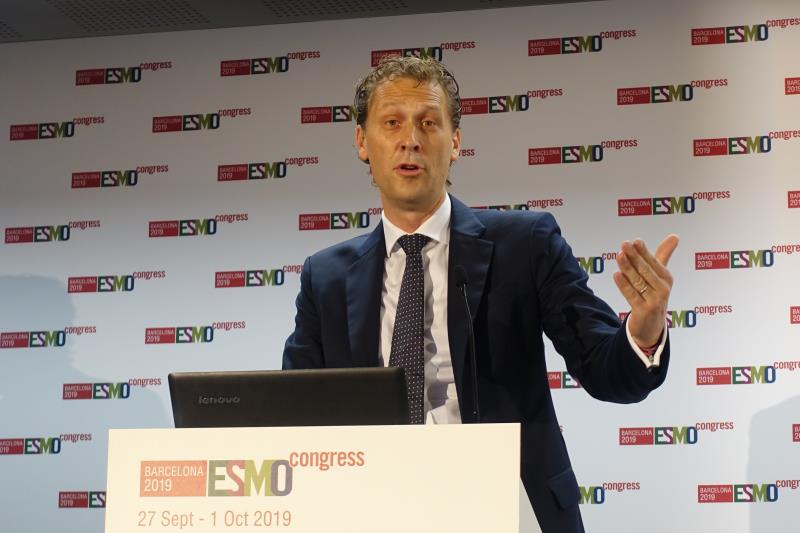 Prof Peter Schmid
Prof Peter SchmidPembrolizumab, used in both neoadjuvant and adjuvant settings, significantly improves pathological complete response (pCR) in patients with early triple-negative breast cancer (TNBC), according to late-breaking results of the phase III KEYNOTE-522 trial presented at the European Society for Medical Oncology (ESMO) Congress 2019.
In this first phase III trial of immunotherapy in early TNBC, patients with newly diagnosed TNBC (T1c N1–2 or T2–4 N0–2) and an ECOG performance status of 0–1 were randomized 2:1 to receive neoadjuvant therapy with pembrolizumab (200 mg Q3W; n=784) or placebo (n=390), both given with 4 cycles of paclitaxel plus carboplatin followed by 4 cycles of doxorubicin or epirubicin plus cyclophosphamide. After definitive surgery, patients continued to receive allocated treatment with pembrolizumab or placebo for 9 cycles or until disease recurrence or unacceptable toxicity. [Schmid P, et al, ESMO 2019, abstract LBA8_PR]
After a median follow-up of 15.5 months, the primary endpoint of pCR (ypT0/Tis ypN0), assessed in the first 602 patients, significantly improved in the pembrolizumab vs placebo group (64.8 percent vs 51.2 percent). “The between-group difference of 13.6 percent [95 percent confidence interval (CI), 5.4 to 21.8; p=0.00055] indicates a clinically meaningful benefit,” said first author, Professor Peter Schmid of the Barts Cancer Institute, Queen Mary University of London, UK.
Similar results were seen for the secondary pCR definitions of ypT0 ypN0 (59.9 percent for pembrolizumab vs 45.3 percent for placebo; difference, 14.5 percent; 95 percent CI, 6.2 to 22.7) and ypT0/Tis (68.6 percent vs 53.7 percent; difference, 14.8 percent; 95 percent CI, 6.8 to 23.0).
“The benefit of pembrolizumab was independent of PD-L1 status, although pCR rates were lower in patients with PD-L1–negative tumours,” said Schmid.
In patients with PD-L1–positive tumours (combined positive score [CPS] ≥1), pCR rates were 68.9 percent for pembrolizumab vs 54.9 percent for placebo, with a between-group difference of 14.2 percent (95 percent CI, 5.3 to 23.1). In those with PD-L1–negative tumours, pCR rates were 45.3 percent vs 30.3 percent, with a between-group difference of 18.3 percent (95 percent CI, -3.3 to 36.8).
“Subgroup analyses revealed a consistent pCR benefit with pembrolizumab regardless of nodal status, tumour size, carboplatin schedule, or patient age,” added Schmid.
Event-free survival (EFS) showed a trend favouring pembrolizumab vs placebo, with a hazard ratio (HR) of 0.63 (95 percent CI, 0.43 to 0.93) that did not reach the boundary for statistical significance (HR <0.4). Estimated EFS rates at 18 months were 91.3 percent vs 85.3 percent.
“Most patients completed treatment as planned, with very low rates of discontinuation. The mean treatment duration and mean number of doses were comparable between the groups,” said Schmid.
Grade ≥3 adverse events (AEs) occurred in 78 percent of patients in the pembrolizumab group vs 73 percent of those in the placebo group, while grade ≥3 immune-mediated AEs occurred in 14.1 percent vs 2.1 percent of the patients. “The safety profile was consistent with what’s known for each regimen,” noted Schmid.
“In the neoadjuvant phase, AEs were mainly driven by chemotherapy, with small differences between the pembrolizumab and placebo groups except for rash [all grades, 21.8 percent vs 15.2 percent],” he said. “In the adjuvant phase, rates of AEs were low and between-group differences were small.”
Immune-mediated AEs were uncommon, the most common being hypothyroidism (all grades, 14.9 percent vs 5.7 percent).